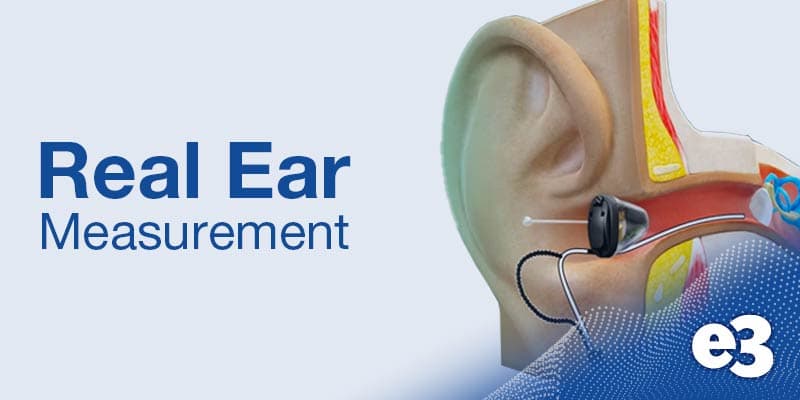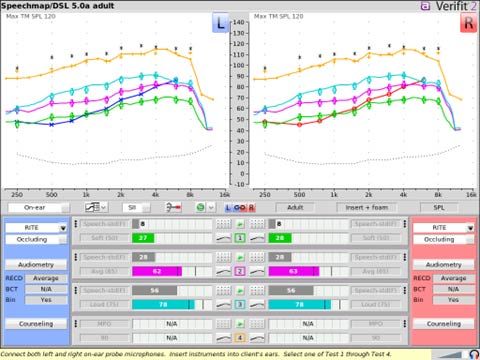What Is a Real Ear Measurement and Why Does it Matter?

Real Ear Measurements (REMs) are the recommended gold standard by the American Speech-Language-Hearing Association (ASHA) for verifying your hearing aids meet your unique hearing needs.
Hearing Care Professionals (HCPs) use real ear measures to assess the performance of your hearing aids in your ears. During REMs, the sound or output of your hearing instruments in your ear canal is measured. These measurements provide valuable information about the effectiveness of the devices.
By conducting REMs, your HCP can make necessary adjustments to optimize your hearing aid settings. This ensures that you are receiving the best possible sound quality and benefit from your hearing instruments.
Performing Real Ear Measures
During REMs, your HCP inserts a small probe tube into your ear canal close to your ear drum. Your HCP then places your hearing aid on your ears. Using specialized real ear measurement equipment, the sound or output of your hearing instrument in your ear canal is measured.
It is important to note that each ear is distinct, even when on the same head. Therefore, measuring sound within your unique ear canal is critical for a precise hearing aid fitting.
Now that you understand what REMs are, let us dive deeper into why REMs are so crucial in the fitting process.

Bilateral Real Ear Measurement (REM) example. Left and right hearing test results marked in blue and red lines. Various input levels (soft, average, loud) applied to the hearing aid and compared (green/pink/blue lines) against your prescribed hearing targets represented by crosses. The Maximum Power Output (MPO) is measured and indicated by the yellow line.
Importance of Performing Real Ear Measurements
- Personalized for Your Unique Hearing Profile: Hearing loss is highly individual, and no two ears are identical. REMs assist your HCP in adjusting your hearing aids by measuring the sound in your ear while you wear them. This ensures that your hearing aids are accurately set to match your unique hearing needs.
- Enhanced Speech Clarity and Sound Quality: REMs aim to optimize your hearing aids for speech clarity and sound quality. By accurately measuring your ear canal’s sound, your HCP can adjust to ensure you can hear conversations more clearly and enjoy a more natural listening experience.
- Safety and Comfort: REMs help prevent discomfort and over-amplification. By verifying that the hearing aid settings are within safe and comfortable limits for your ears, REMs protect you from potential harm and distress associated with overly amplified sounds.
- Meeting Prescribed Targets: When you receive a hearing aid prescription from your HCP, REMs help confirm that your hearing aid meets those prescribed targets. This verification step ensures that your investment in better hearing is well-founded, and you get the intended benefits.
- Long-Term Effectiveness: Hearing needs can change over time, so regular REMs can help track your hearing progress and make necessary adjustments to your hearing aids, meaning that your hearing aids remain effective and continue to provide the support you need as your hearing changes.
- Troubleshooting and Fine-Tuning: REMs can also be invaluable for troubleshooting any issues with your hearing aids. If you experience difficulties or changes in your hearing, your HCP can use REMs to pinpoint the problem and make precise adjustments.
Consequences of Not Performing Real Ear Measures
Depending solely on “quick fitting” hearing aids guided by manufacturer software may not consistently represent the actual conditions within your ear. Discrepancies between the software and your individual ear characteristics can impact your capacity to hear sounds and understand speech effectively.
If your HCP does not perform real ear measures, they might not catch any problems with your hearing aids. Furthermore, fine-tuning your hearing aids based on real ear measures ensures that the adjustments made are precise and tailored to your specific needs. This personalized approach can enhance your overall hearing experience, allowing you to fully maximize the benefits of your devices.
In summary, neglecting real ear measures can result in suboptimal performance of your hearing aids. It is essential to rely on these measures to troubleshoot any issues, make accurate adjustments, and ensure that you are receiving the best possible hearing experience.
REMs are invaluable in hearing aid fitting, offering you a personalized listening experience and are considered best practice. REMs enhance the comfort, safety, and overall effectiveness of your hearing aids.
When considering purchasing hearing aids, selecting a clinic that offers REMs, coupled with the expertise of a hearing care professional, guarantees you get the most out of your investment in better hearing.
